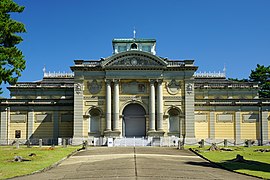Katayama Tōkuma
Katayama Tōkuma ( Japanese 片 山 東 熊 ; * January 18, 1854 in Hagi ; † October 24, 1917 ) was one of the first modern architects in Japan.
Live and act
Katayama was born the son of a samurai in Hagi. He belonged to the first class of the Department of Architecture of the newly established Institute of Technology ( 工部大学校 , KOBU Daigakkō , today Faculty of Engineering of the University of Tokyo ) in Tokyo, which in 1879 graduated. Among his fellow students were Tatsuno Kingo and Sone Tatsuzo . He was then the Ministry of Public Works ( Kobu-shō set).
In 1881 he participated in the construction of the villa for Prince Arisugawa, with which Josiah Conder had been commissioned. This gave him a connection to the Imperial Court Office and was able to participate in other projects for the imperial family. In 1886 he became a member of the Bureau for the Construction of the Imperial Palace and made a career in this function.
Katayama's buildings are all based on Western models, especially buildings from the French Renaissance. After the death of Meiji-Tennō in 1912, Katayama directed the structures for the funeral ceremony and for the imperial tomb.
Buildings (selection)
- Nara National Museum (1894), an important cultural asset of Japan
- Kyōto National Museum (1895), an important cultural asset of Japan
- Jinpū-kaku ( 仁 風 閣 ; 1906), residence of the Ikeda in Tottori , an important cultural asset of Japan
- Akasaka Palace (1906), now the Government Guest House, National Treasure of Japan
- Hyōkei-kan ( 表 慶 館 ; 1908), building on the grounds of the Tokyo National Museum , an important cultural asset of Japan
photos
literature
- Tazawa, Yutaka: Katayama Tokuma. In: Biographical Dictionary of Japanese Art. Kodansha International, 1981. ISBN 0-87011-488-3 .
Web links
| personal data | |
|---|---|
| SURNAME | Katayama, Tōkuma |
| ALTERNATIVE NAMES | 片 山東 熊 (Japanese) |
| BRIEF DESCRIPTION | Japanese architect |
| DATE OF BIRTH | January 18, 1854 |
| PLACE OF BIRTH | Hagi |
| DATE OF DEATH | October 24, 1917 |





